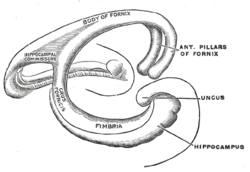- Commissure of fornix
-
Brain: Commissure of fornix 
Diagram of the fornix. (hippocampal commissure labeled at center left.) Latin commissura fornicis, commissura hippocampi Gray's subject #189 838 NeuroNames hier-255 NeuroLex ID birnlex_746 The lateral portions of the body of the fornix are joined by a thin triangular lamina, named the psalterium (lyra). This lamina contains some transverse fibers that connect the two hippocampi across the middle line and constitute the commissure of fornix (hippocampal commissure).
The terminal lamina creates the commisure plate. This structure gives existence to the corpus callosum, the septum pellucidum, and the fornix. The latter splits into two columnae fornicis (anterior), and then splits into two crura fornicis (posterior). These two crura are joined together through the commissura hippocampalis. The beginning of the splitting is called the psalterium or Lyra Davidis. The latter name is used because the structure resembles a lyra (or triangular harp): The two crura are the "chassis" of the lyra, and the commisure connections are the fibers.
External links
This article was originally based on an entry from a public domain edition of Gray's Anatomy. As such, some of the information contained within it may be outdated.
Human brain, cerebrum, Interior of the cerebral hemispheres, white matter: commissural fibers and septum (TA A14.1.09.241–271, 569–571, GA 9.828, 838–840) Corpus callosum Lamina terminalis Fornix Septum pellucidum Categories:- Nervous system
- Neuroscience stubs
Wikimedia Foundation. 2010.
